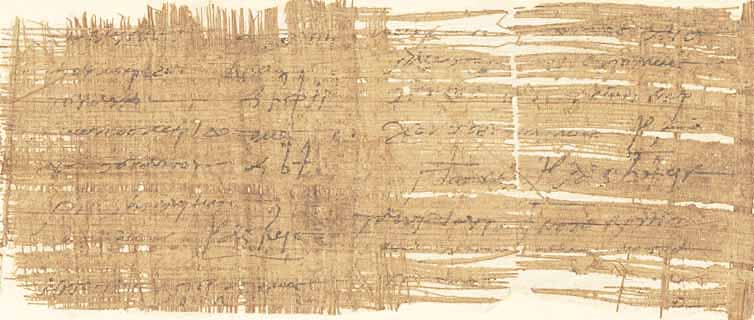BKT IX 16 (P. 21260 V)
In European stories, the wolf is often portrayed as a predatory villain. For example, in “Little Red Riding Hood”, a fable by the Brothers Grimm, he deceives an innocent young girl in order to eat her greedily. But has the wolf always been a cold-blooded foe or was he even a salutary hero in ancient literature?
The papyrus was probably purchased in the Fayum, a large oasis southwest of Kairo, and dates from the 3rd century AD. The piece was written in Greek and is inscribed on both sides. On the recto side there is a billing, but the verso side reveals a far more interesting content: it is a magical formula for preparing an amulet.
The requisites of the magical procedure are mentioned in the course of the seven lines. One should take lamellas, wrap something with linen, use an unknown ingredient of a black wolf and finally contain something in a small vessel. Then the amulet will serve the reader often. As the piece is only a fragment and also has holes in it, the connections between the components are missing. Nevertheless, several things can be said about the transmitted text.
Amulets have been around since the Predynastic period of Ancient Egypt and their use continued from the Pharaonic period to the Greek-Roman and Christian periods. They protect the owner from evil, bestow health, make prophecies and accompany the deceased in the afterlife. It is not unusual for an amulet to be wrapped in linen, as linen and flax were considered religiously pure. They were said to be connected to the sky and the sun. This is why, in addition to its many uses as bandage and writing material, clothing or lamp wicks, linen was also frequently used in the cult of the dead. For example, mummification material, burial objects or sacrifices and clothing for the gods were made of linen.
What is extremely unusual about the spell instructions, however, is the mention of a black wolf, as no other Greek magical papyrus mentions a black wolf. Only one Greek magical Christian papyrus, which is housed in the Papyrus Collection of Cologne nowadays, mentions a white wolf. Here the white wolf appears and heals Joseph’s trembling and fever, as Joseph is wearing his protective amulet.
Many positive medical effects were attributed to the wolf in the Greek world. For example, the sun-dried liver of a wolf fattened with figs combined with laurels, peppercorns, honey and sweet wine cures coughs, tuberculosis, stomach pains and flatulence. Binding a salted right wolf’s eye on the body helps against intermittent fever. The fat of the wolf helps against hardening, for instance of the uterus. If wolf skin is tanned in alum and applied to the affected area for six days, it also helps against loin pain. Even the wolf’s excrement was said to have a medical effect. If it is mixed with Attic honey and processed into an ointment, it cures cataracts when applied to the eye.
As can be seen from the text of the papyrus, wolves were also believed to have magical abilities. A wolf’s snout on the farm gate or a wolf skin strap on the wrist protected against death through poisoning, a wolf’s tail tied to a feeding trough prevented the animal from swallowing cattle bones and if a wolf’s tooth was tied to a horse, it became tireless. If a wolf bites a horse, it also runs stronger and faster, a sheep killed by a wolf tastes better and, on top of that, prey killed by a wolf even has healing powers.
Despite the many positive associations of the wolf at the time of the Ancient Greeks, it was already known then as an evil predator at the same time. The wolf was also regarded as an animal of misfortune, and its howling prophesied three days of bad weather. In particular, an encounter with a wolf with prey in its mouth, blocking your path from right to left, was regarded as a worrying omen.
In the end, the exact instructions for this spell and its use remain a mystery to the reader. Nevertheless, the viewer is all the more challenged to speculate about the puzzles of the piece, be it the varied uses of the linen or the ambivalent role of the wolf in the ancient world. Thus, this papyrus proves that incompleteness does not make a piece any less exciting.



